
Color Scale for Wines wine
A dryness scale is a way of measuring the level of dryness in a wine. It is based on the amount of residual sugar left in the wine after fermentation. The more residual sugar, the sweeter the wine. The less residual sugar, the drier the wine. The dryness scale is used to classify wines according to their sweetness or dryness.

Wines From Dry to Sweet (Chart) Wine Folly
April 9, 2021 Ranking wines by driest white wine to sweetest is a great way to begin describing a wine. In most cases, the first thing we say about a white wine is whether it is sweet or dry as a baseline to describe the wine. Or you'll hear, "I like dry white wines," or "I like white wines that aren't too sweet," but what does that mean exactly?

What is a Dry White Wine? A Complete Guide Brokenwood Wines
Winemakers often use terms like "dry," "off-dry," or "sweet" to signal the wine's sweetness level. But the real secret lies in the residual sugar (RS) content, measured in grams per liter (g/L). A wine with less than 4g/L is bone-dry, 4-12g/L is considered off-dry, and anything above 12g/L ventures into sweet territory.

wine chart I Love Wine
What Makes a White Wine Dry? The term "dry" does not indicate a wine without wetness. As a liquid, all wine is wet. Instead, dry refers to the sweetness present in a wine. All vino is rated based on this sweetness scale, with dry wines having far less sugar or residual sugar lingering behind after each taste.

Wine Chart The Only Wine Sweetness Chart You’ll Ever Need Wine chart, Alcohol recipes, Wine
Dry white wine is any white wine that does not taste sweet due to the low amount of residual sugar in the drink. Low amounts of residual sugar might be zero, 10 grams per liter, or as little as 4 grams per liter. A sugar concentration of one percent can also be considered dry.
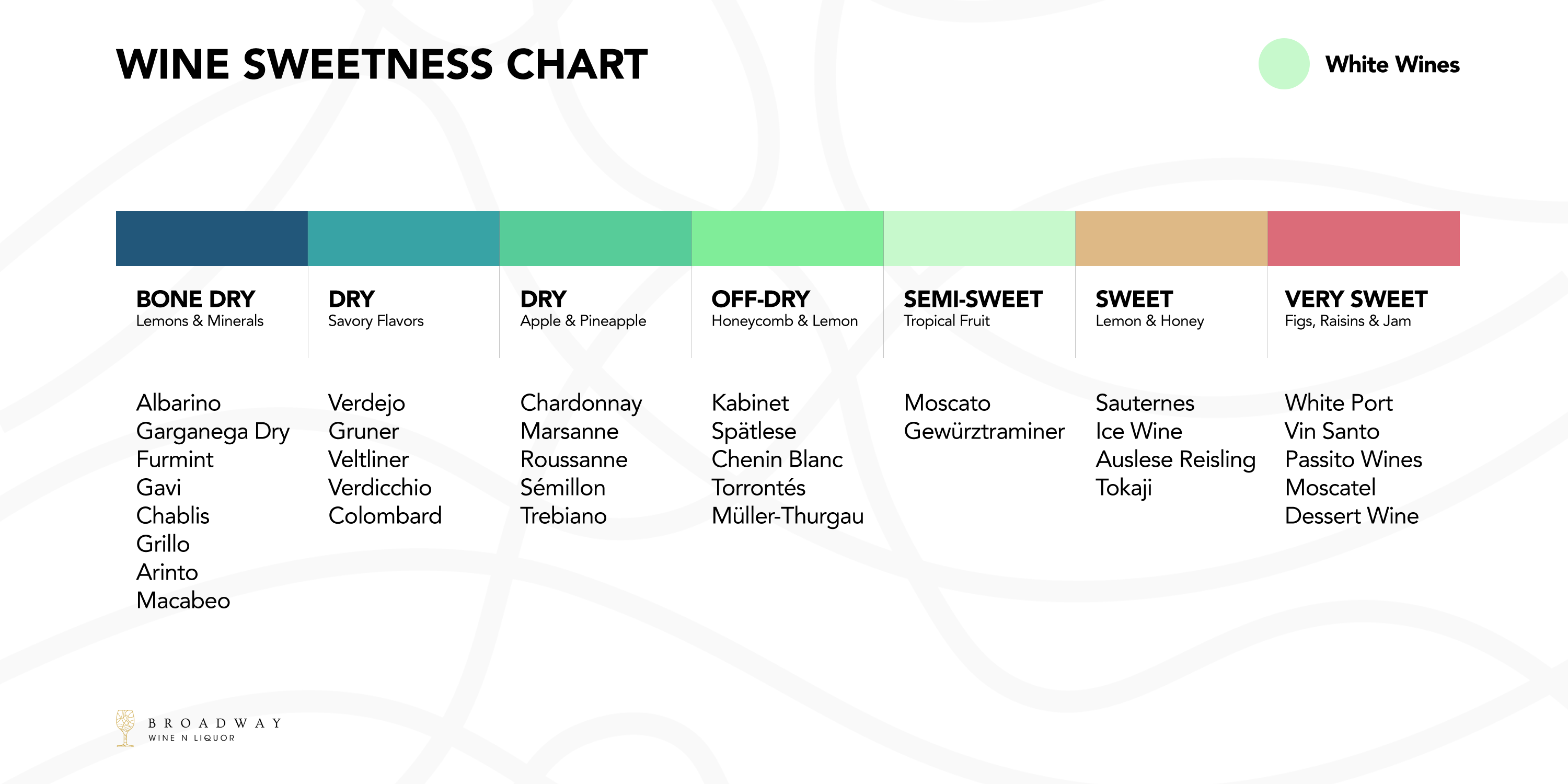
Wine Sweetness Chart 🍇 Broadway Wine N Liquor
Certain white wines are almost always made dry — Sauvignon Blanc, Pinot Grigio, and Spanish Albariños. Many wines fall in the wide, wonderful world of medium-dry — Pinot Gris, Rieslings, and New World Chardonnays. As for perennially sweet wines, those might come from late-harvest grapes like Riesling and Chenin Blanc.

Types Of White Wine Chart
Dry White Wine List for People Who Like Sweet Wine White Wine Sweetness Chart We've organized the white wines here on a scale from dry to sweet. You'll find that there are more dry wines than sweet wines. In fact, most of the white wines that you're probably familiar with are dry white wines.
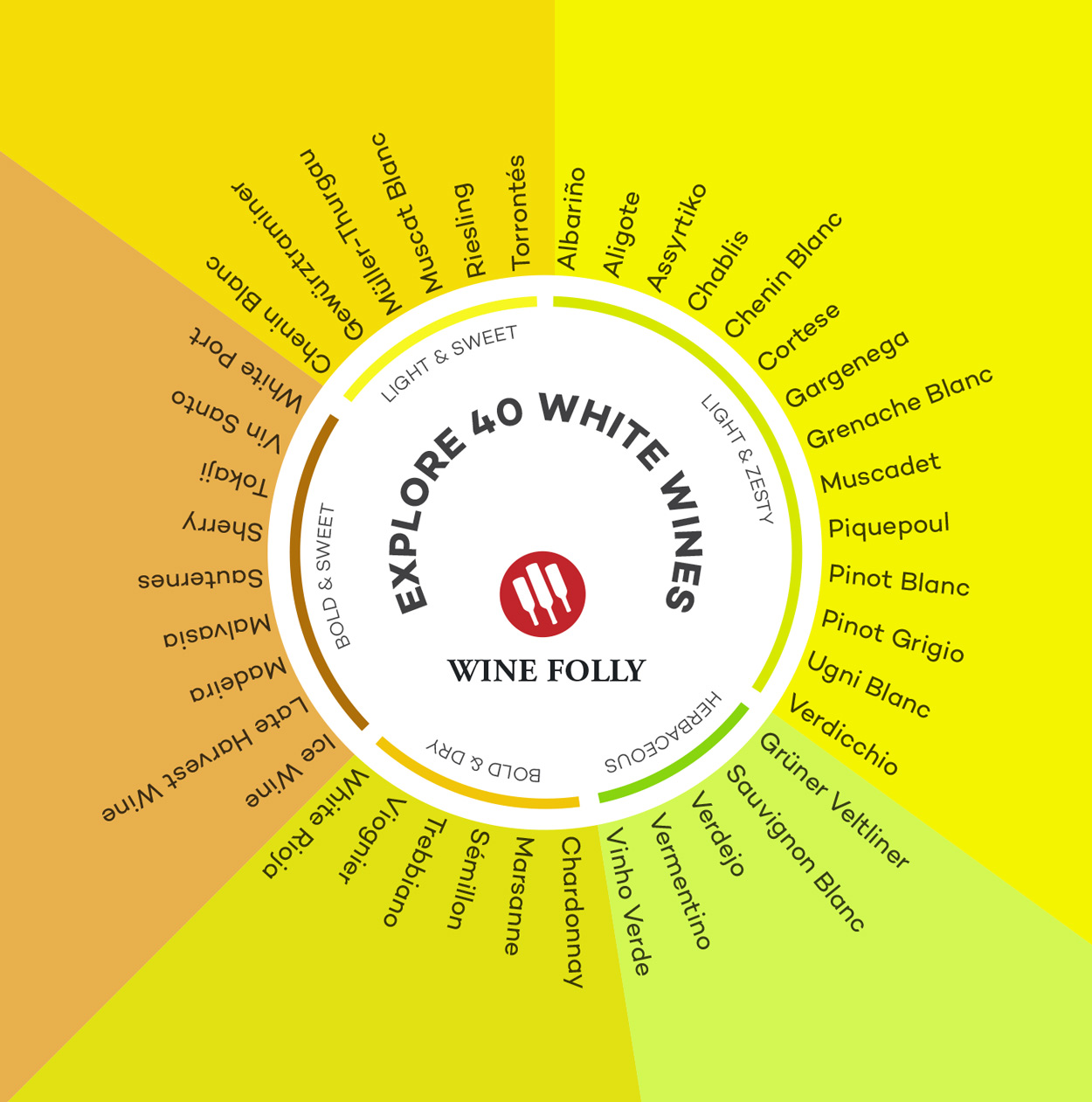
Basic Guide to White Wine Wine Folly
For white wines, pretty much only three regions in Europe traditionally make high quality off-dry or "harmoniously sweet" table wines: the Loire Valley (for Chenin Blanc), Pinot Gris, Riesling, Gewurtztraminer, and Muscat from Alsace in France, as well as much of the Riesling from Germany (although, there is also dry German Riesling).
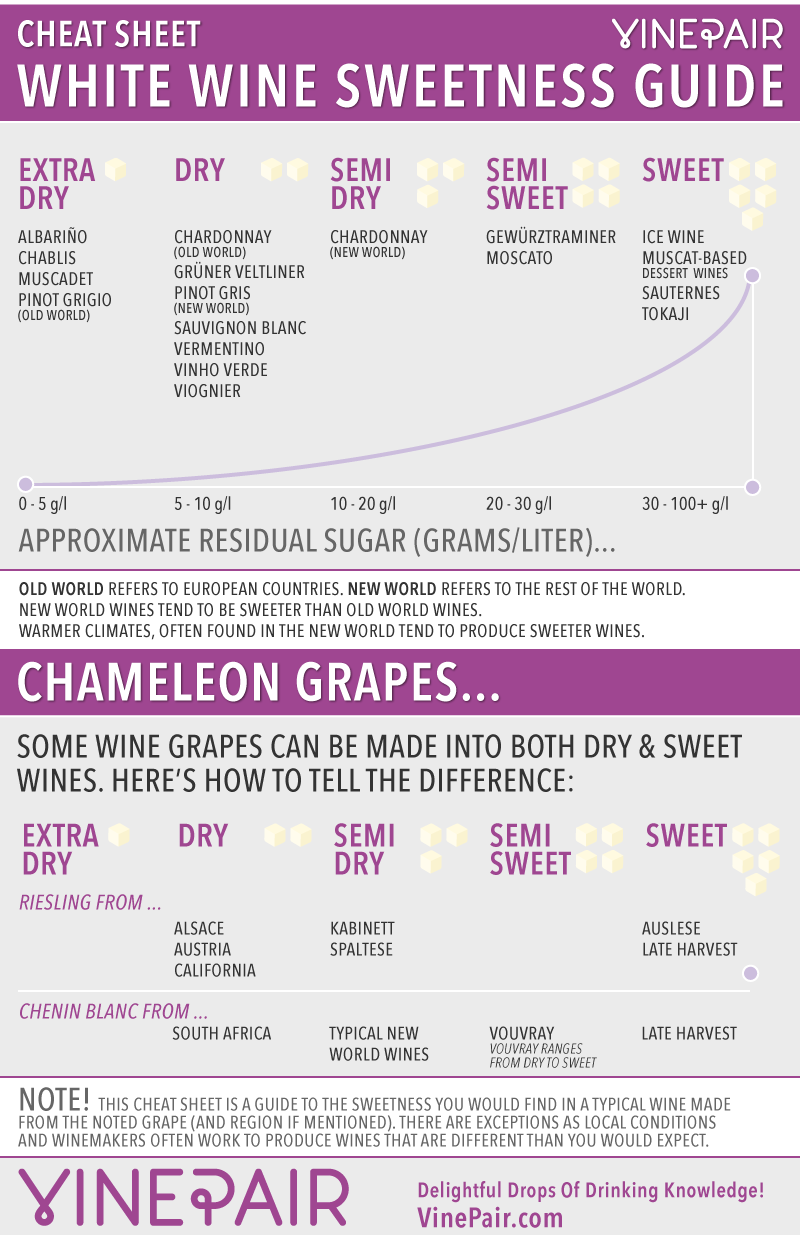
CHEAT SHEET White Wine Sweetness Chart & Guide VinePair
Dry white wines, on the other hand, are made from grapes such as Sauvignon Blanc, Chardonnay, Pinot Grigio, and Semillon. These wines are usually higher in alcohol and have a crisp, mineral, and acidic flavor. When it comes to choosing a white wine, it is important to understand the sweetness scale.
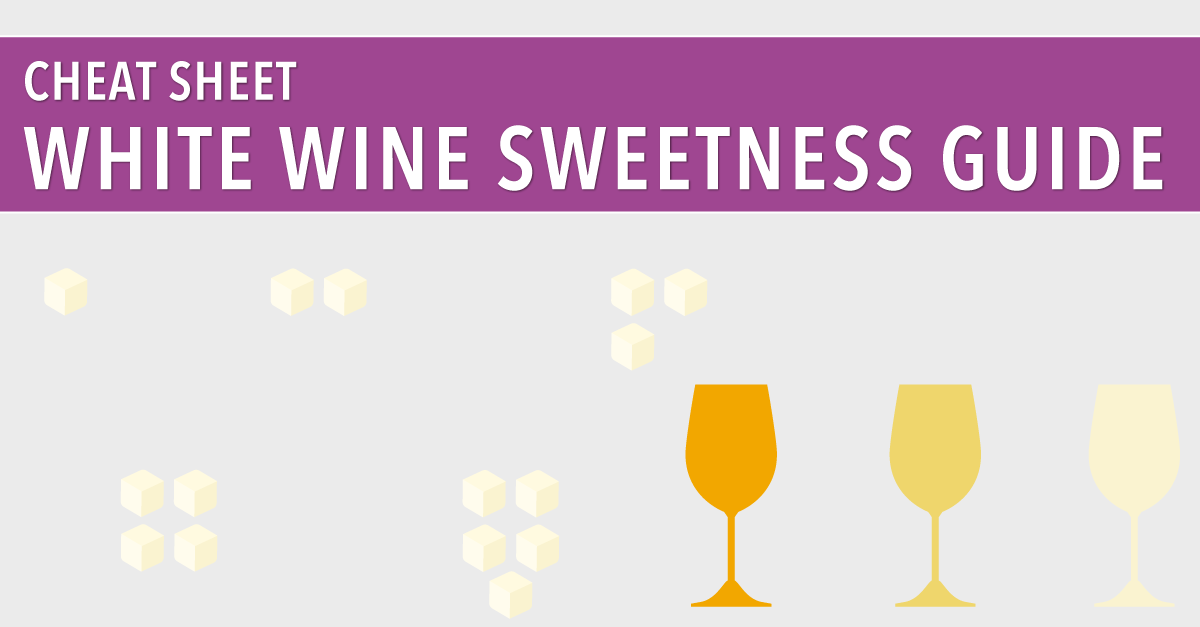
CHEAT SHEET White Wine Sweetness Chart & Guide VinePair
Soave: Delicate, fragrant, sushi-friendly Italian white made from the garganega grape. Vinho Verde: Lightly sparkling, fragrant Portuguese blend from local grapes. Assyrtiko: A light but full-flavoured Greek white that tastes great with Halloumi cheese. Orvieto: Dry, round but fragrant Italian white, delicious with macaroni cheese or Greek salad.
Discover the 14 Driest White Wines (Dry to Sweet Wine Chart) Unraveling Wine
(So useful!) When reading a tech sheet: Below 1% sweetness, wines are considered dry. Above 3% sweetness, wines taste "off-dry," or semi-sweet. Wines above 5% sweetness are noticeably sweet! Dessert wines start at around 7-9% sweetness. By the way, 1% sweetness is equal to 10 g/L residual sugar (RS).

White Wine Sweetness Chart (Printable!)
But first, what is the driest white wine? Dryness in wine refers to the absence of residual sugar. During the winemaking process, yeast consumes the grape's sugars, turning them into alcohol. The less sugar left behind, the drier the wine. To understand this, wines are categorized as follows on the sweetness scale: Sweet: High residual sugar.

This Wine 101 Series of Charts Will Have You Looking Like An Expert [INFOGRAPHIC] Wine chart
Types of dry white wine. Wines made from these common white wine grape varieties are generally dry. Though, again, certain producers' versions may be a little sweet to satisfy their particular customers. Albariño - This Spanish variety, most famously from the Rias Baixas region is typically bone dry.
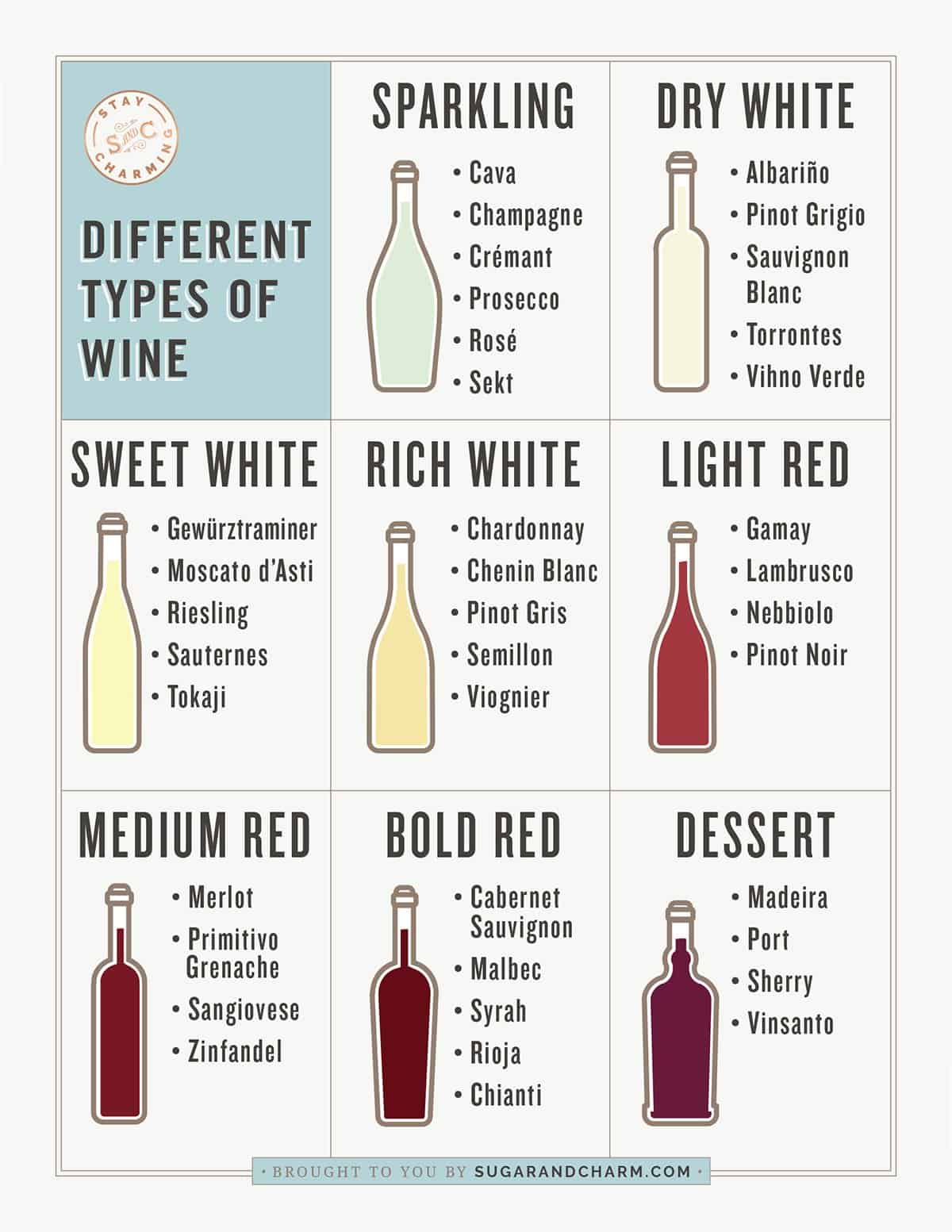
5 Drinks Every Man Must Know How to Make and Drink
Dry white wines include lemon and mineral flavors primarily and include options like Italian Pinot Grigio, Gavi, Muscadet, Vinho Verde, and Arinto.

Wines Listed from Dry to Sweet (Charts) Wine Folly in 2020 Wine folly, Wine chart, White wine
In general, some whites wines are almost always made in a dry style: Sauvignon Blanc, Pinot Grigio, Spanish Albariños and Austrian Grüner Veltliners, for example. Some wines often fall between dry and off-dry: many New World Chardonnays, Rieslings, Viogniers and Pinot Gris, for example.

White Wine Sweetness Chart Cellars Wine Club
A clarification is need here. A Dry sparkling wine is actually noticeably sweet. It contains in fact between 17 to 32 g/l. If you are after a non sweet Sparkling wine ask for Brut or a Brut Nature. Here are the sweetness levels: Brut Nature less than 3 g/l. Extra Brut less than 6 g/l. Brut less than 12 g/l.